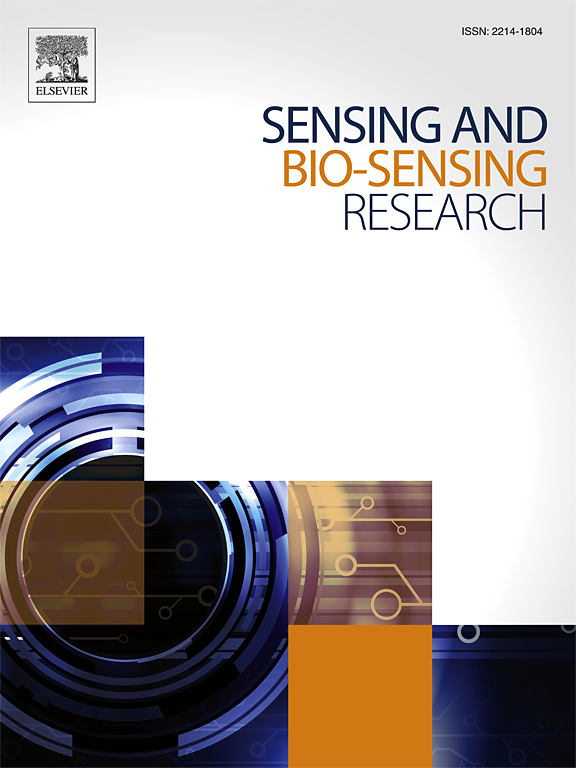Yerba mate tea mediated synthesis of nanoscale zero valent iron particles and their application in detection of Pb ions in water
IF 5.4
Q1 CHEMISTRY, ANALYTICAL
引用次数: 0
Abstract
Yerba-mate tea extracts were used to successfully synthesise nanoscale zero-valent iron (NZVI) particles. The tea extracts acted as both the reducing and capping agents. The morphological, optical and structural properties were characterized using Transmission Electron Microscope (TEM), X-ray Diffraction (XRD), UV–vis absorption spectroscopy and Fourier Transform Infrared (FTIR) spectroscopy, respectively. The XRD and FTIR confirmed a complete reduction of Fe ions forming nanoparticles with an average size of 3 to 3.5 nm synthesized at 25 °C as shown by TEM images, indicating enhanced electrocatalytic sites. The as-synthesized NZVI particles were immobilized on AuSPE and evaluated on the electrocatalytic behaviour using ferri/ferrocyanide as a redox probe. Thus, they were modified on the screen-printed carbon electrodes to fabricate an electrochemical sensor for Pb2+ detection. The sensor was optimised to detect traces of Pb ions from 5 to 9 parts per billion concentrations. The surface concentration of the adsorbed electro-active film on the reduction half of AuSPE/NZVI modified electrodes was determined and estimated to be 1.32 × 10−10 mol cm−2. Moreover, the charge transfer coefficient of AuSPE/NZVI particles was estimated to be 5.43 × 10−17 cm2s−1. The sensor gave a relatively low limit of detection 2.56 ppb for Pb2+ ions. This was lower than most commercially available heavy metal detectors with a detection limit of 3.5 ppb.
马黛茶介导纳米级零价铁粒子的合成及其在水中铅离子检测中的应用
利用马黛茶提取物成功合成了纳米级零价铁(NZVI)颗粒。茶提取物具有还原和封盖作用。利用透射电镜(TEM)、x射线衍射(XRD)、紫外-可见吸收光谱(UV-vis)和傅里叶变换红外光谱(FTIR)分别表征了材料的形态、光学和结构性质。TEM图像显示,XRD和FTIR证实在25℃下合成的铁离子完全还原,形成平均尺寸为3 ~ 3.5 nm的纳米颗粒,表明电催化位点增强。在AuSPE上固定化了合成的NZVI颗粒,并以铁/亚铁氰化物为氧化还原探针对其电催化性能进行了评价。因此,将它们修饰在丝网印刷的碳电极上,以制造用于Pb2+检测的电化学传感器。该传感器经过优化,可以检测到十亿分之五到十亿分之九浓度的痕量铅离子。测定了AuSPE/NZVI修饰电极的还原一半上吸附的电活性膜的表面浓度,估计为1.32 × 10−10 mol cm−2。此外,AuSPE/NZVI粒子的电荷传递系数估计为5.43 × 10−17 cm2s−1。该传感器对Pb2+离子的检测限相对较低,为2.56 ppb。这比大多数商用重金属探测器的检测极限3.5 ppb要低。
本文章由计算机程序翻译,如有差异,请以英文原文为准。
求助全文
约1分钟内获得全文
求助全文
来源期刊

Sensing and Bio-Sensing Research
Engineering-Electrical and Electronic Engineering
CiteScore
10.70
自引率
3.80%
发文量
68
审稿时长
87 days
期刊介绍:
Sensing and Bio-Sensing Research is an open access journal dedicated to the research, design, development, and application of bio-sensing and sensing technologies. The editors will accept research papers, reviews, field trials, and validation studies that are of significant relevance. These submissions should describe new concepts, enhance understanding of the field, or offer insights into the practical application, manufacturing, and commercialization of bio-sensing and sensing technologies.
The journal covers a wide range of topics, including sensing principles and mechanisms, new materials development for transducers and recognition components, fabrication technology, and various types of sensors such as optical, electrochemical, mass-sensitive, gas, biosensors, and more. It also includes environmental, process control, and biomedical applications, signal processing, chemometrics, optoelectronic, mechanical, thermal, and magnetic sensors, as well as interface electronics. Additionally, it covers sensor systems and applications, µTAS (Micro Total Analysis Systems), development of solid-state devices for transducing physical signals, and analytical devices incorporating biological materials.
 求助内容:
求助内容: 应助结果提醒方式:
应助结果提醒方式:


